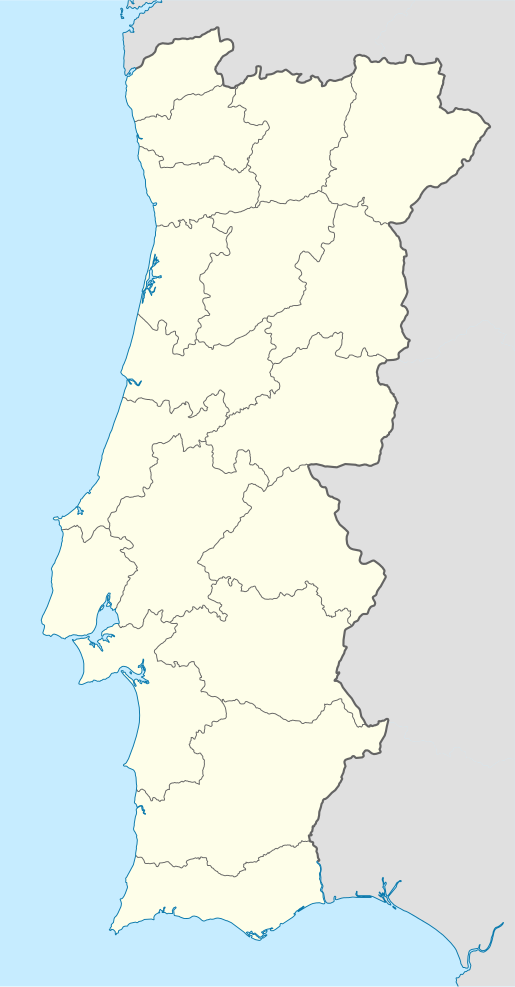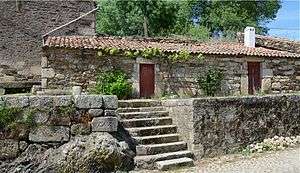Idanha-a-Velha
Idanha-a-Velha is a village and a former freguesia (civil parish) in the municipality of Idanha-a-Nova, central eastern Portugal, and the site of Ancient Egitânia, a former bishopric.
Idanha-a-Velha | |
|---|---|
 View of the village, with River Ponsul | |
 Idanha-a-Velha Location in Portugal | |
| Coordinates: 39.997°N 7.144°W | |
| Country | |
| Region | Centro |
| Intermunic. comm. | Beira Baixa |
| District | Castelo Branco |
| Municipality | Idanha-a-Nova |
| Disbanded | 2013 |
| Area | |
| • Total | 20.98 km2 (8.10 sq mi) |
| Population (2001) | |
| • Total | 79 |
| • Density | 3.8/km2 (9.8/sq mi) |
| Time zone | UTC±00:00 (WET) |
| • Summer (DST) | UTC+01:00 (WEST) |
| Website | www.cm-idanhanova.pt |
In 2013, the civil parish merged into the new parish Monsanto e Idanha-a-Velha.[1] It covers an area of 20.98 km² and had a population of 79 as of 2001.
History

As one of the oldest towns in Portugal, with a history of Roman settlement recorded since the year 16 AD,[2] Idanha-a-Velha has been described as a "modest village with a rich historical background".[3] Idanha-a-Velha is built on the site of the city of Egitânia, which previously had thousands of inhabitants. The town was repeatedly invaded and looted throughout history, and the ruins evince the influence of different periods of its history: buildings from the Pre-History, Celtic, Roman Classicism, Suebic, Visigothic, Arabic, Middle Ages and Portuguese Manueline periods.
The town is reputed to have been the birthplace of the famous Visigothic King Wamba,[3] as well as the fourth century Saint Pope Damasus. The Visigoth King Roderic is also said to have been buried here.
The town is host to a restored 16th century church, called "the Cathedral",[4] built on ruins dating from the time of the Suebi, as far back as to the fourth century — the first Visigothic cathedral built on the Iberian Peninsula.[2] The inside of the cathedral holds the largest collection of Roman epigraphs in Europe,[2] refurbished as a modern museum to contain the carved and inscribed Roman stones.[3]
There is also a 17th-century pillory in the village square.[3] Nearby stand the ruins of a Torre dos Templários, a tower constructed on the ruins of a Roman temple dedicated to Venus.[3]
Ecclesiastical History
The presence of a primitive basilica (Roman church) constructed in the 4th century influenced King Theodemar of the Suebic Kingdom of Galicia (+570) to choose this town as see when he created the Diocese of Egitânia no later than 559–569.[5][6] Around 585, the Romanesque cathedral started to be constructed, that included not only the main structure by the baptistery and the hypothetical palace.[6] That was also the year that Suebic Galicia was annexed by the Visigoths, and was turned into the sixth province of the Visigothic Kingdom of Hispania.

In 715 however, the diocese was suppressed (possibly with an apostolic succession of errant bishops), due to the Moorish invasion of Iberia, rendering the church's cathedral function mute. Between the 9th and 10th century, during the Moorish occupation, the temple was transformed into mosque.[6]
When the bishopric could finally be restored in 1199 (after the Reconquista), initially at Idanha-a-Velha, its apostolic succession was assigned to a new see, after which it was (re)named Diocese of Guarda, where a new cathedral was built, while the former cathedral at Idanha-a-Velha, which had served local purposes, notably under Knights Templar influence, was not even made a co-cathedral.
- Suffragan Bishops of Egitânia [7]
- Adorico (550?569 – 572?)
- Comundo (? – 589)
- Licério (? – 610)
- Montésis (? – 638)
- Arménio (? – 646)
- Siclua (? – 666)
- Monefonso (? – 688)
- Argesindo (? – 693)
- Rodrigo (1199–1199)
References
- Diário da República. "Law nr. 11-A/2013, pages 552 58-59" (pdf) (in Portuguese). Retrieved 23 July 2014.
- "Idanha-a-Velha". Freguesias (in Portuguese). Câmara Municipal de Idanha-a-Nova. Archived from the original on 2008-03-03. Retrieved 2008-02-28.
- "Castelo Branco". Portugal Travel. Retrieved 2008-02-28.
- "Catedral Visigótica de Idanha-a-Velha". Visit Portugal. 2006. Archived from the original on 2012-03-12. Retrieved 2008-02-28.
- In 569, the Bishop of Egitânea was present at the Council of Lugo, confirming the existence of the bishopric.
- Conceição, Margarida; Costa, Marisa (2001), SIPA (ed.), Catedral de Idanha-a-Velha (IPA.00005882/PT020505040010) (in Portuguese), Lisbon, Portugal: SIPA – Sistema de Informação para o Património Arquitectónico, archived from the original on 13 March 2016, retrieved 1 December 2016
- http://www.gcatholic.org/dioceses/diocese/guar3.htm GCatholic - Egaria bishopric
Sources and external links
| Wikimedia Commons has media related to Idanha-a-Velha. |